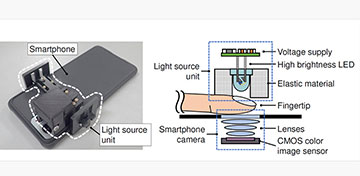
Using commercial visible and near-infrared sensors, such as those in smartphones and smartwatches, it is reportedly possible to estimate blood glucose levels noninvasively based on the asynchronicity between oxyhemoglobin and deoxyhemoglobin oscillations. [Image: Nakazawa et al., doi 10.1117/1.JBO.29.3.037001]
About 38 million people in the United States have diabetes—or one in every 10 individuals—and that number is projected to increase to 55 million by 2030. Patients must precisely monitor and carefully control their blood glucose level to keep it within a normal range and prevent complications of the disease.
Current methods of measuring blood glucose involve needles, making them invasive and painful. Now, researchers in Japan have demonstrated the feasibility of noninvasive glucose monitoring with visible and near-infrared (NIR) light (J. Biomed. Opt., doi: 10.1117/1.JBO.29.3.037001). The approach, which still requires significant testing and validation, mines data from existing photoplethysmography sensors to calculate a metabolic index.
The “holy grail” of biosensing
Countless devices and companies have attempted to achieve what has been dubbed the “holy grail” of biosensing—noninvasive glucose monitoring—and all have ultimately failed.
Many have tried the avenue of NIR spectroscopy, but while glucose has several absorption peaks in the NIR region, they are broad and weak, and they overlap with other interferences, such as water or lipids. The Raman spectrum for glucose can be clearly distinguished from those of other biological compounds, but the signal tends to be very weak. Lastly, glucose has a strong absorption peak in the mid-infrared (MIR) region, but optical components used for MIR spectroscopy can be expensive and bulky.
The current study takes a unique approach that utilizes practical and low-cost visible and NIR spectroscopy. The authors report on a metabolic index, which represents the degree of oxygen consumption in each cardiac cycle and is thought to be closely related to blood glucose from a cellular metabolism viewpoint. In practice, it is calculated as the phase delay between oxyhemoglobin and deoxyhemoglobin signals—a value that appears to correlate with blood glucose levels.
A single male subject with no underlying health conditions underwent different types of oral glucose challenges, and the metabolic index agreed moderately well with values from a reference continuous glucose monitor.
Oral glucose challenge
The researchers investigated the metabolic index with two types of prototype devices: a Samsung Galaxy Watch with red (650 nm) and NIR (950 nm) LEDs and a Samsung Galaxy S21 Ultra 5G smartphone with a high-brightness green LED (525 nm). A single male subject with no underlying health conditions underwent different types of oral glucose challenges, and the metabolic index agreed moderately well with values from a reference continuous glucose monitor.
In future studies, they plan to evaluate the method in both healthy and diabetic subjects, as well as look into improving the estimation accuracy by applying corrections based on the oscillation amplitude of the optical path length. “The proposed method can in principle be implemented in existing smart devices with a pulse oximetry function and is inexpensive, battery-saving and simple compared with other noninvasive blood glucose monitoring techniques,” said study author Tomoya Nakazawa of Hamamatsu Photonics in a press release accompanying the work. “Thus, our approach could be a powerful tool toward portable and accessible BGL monitoring devices in the future.”
